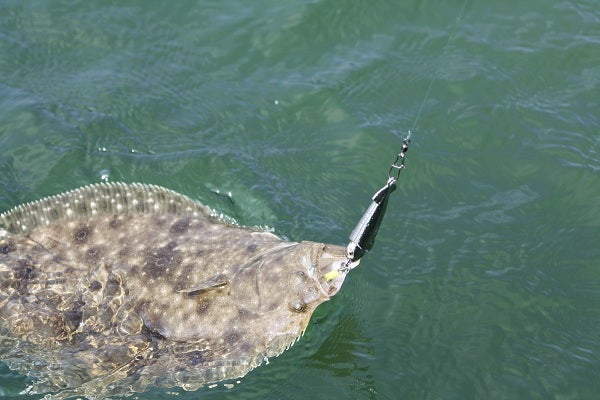Fisheries managers say federal decision on summer flounder hurts conservation efforts

A hooked summer flounder. (Public domain image)
Interstate fishing managers say a row with a Trump administration appointee over the regulation of summer flounder fishing off New Jersey jeopardizes conservation of marine species all along the East Coast.
The regulatory Atlantic States Marine Fisheries Commission announced in June that it had found New Jersey out of compliance with management of the fishery. The commission is under the auspices of the National Oceanic and Atmospheric Administration.
The New Jersey Department of Environmental Protection earlier this year announced new rules requiring a minimum 18 inch size of summer flounder, also known as fluke, for most coastal waters. The fluke season began on May 25 and ends on September 5 but was subject to closure due to the dispute.
Anglers in these areas may keep three legally sized fish per day. The size limit for Delaware Bay was set 17 inches, with a three-fish per day limit. At Island Beach State Park the state set a size limit for shore fishing at 16 inches, with a daily two-fish limit.
Earlier this month, following more than a month of controversy, Secretary of Commerce Wilbur Ross reversed the Atlantic State Marine Fisheries Commission ruling and affirmed New Jersey’s regulations. The Department of Commerce controls NOAA.
An Atlantic States spokeswoman says Ross’ ruling is extremely rare and has the potential to soften the commission’s regulatory authority.
But a Department of Commerce spokesman says Ross feels alternative measures implemented by New Jersey are adequate to protect the fish’s population.
The DEP recently launched an educational campaign about the proper handling of fluke.
The “If You Can’t Keep It, Save It!” imitative focuses on techniques to reduce unintentional moralities that can occur when flounder that do not meet minimum length requirements are returned to the water.
The state Division of Fish and Wildlife encourages anglers to follow these recommendations:
Plan ahead – Expect to release fish and have the necessary equipment to do so, including de-hookers and proper nets; more experienced anglers may also consider using a recompression tool, a device that allows fish to be returned to the water at a safer depth.
Use appropriate gear – Use gear suited to the size of the fish that you are trying to catch; 5/0 to 7/0 size hooks are recommended to successfully land bigger fish and reduce discards.
Handle fish carefully – Use knotless, rubberized landing nets and rubberized gloves to avoid removing the protective slime layer on fish and help ensure survival when it is placed back in the water.
—————————————————————–
The Associated Press contributed to this report.
WHYY is your source for fact-based, in-depth journalism and information. As a nonprofit organization, we rely on financial support from readers like you. Please give today.

